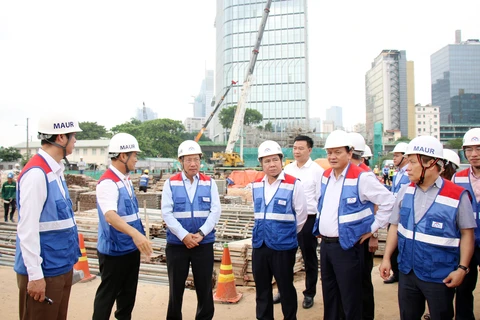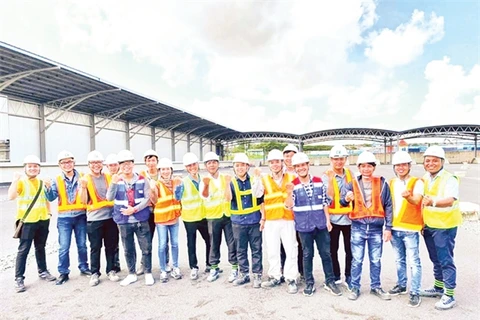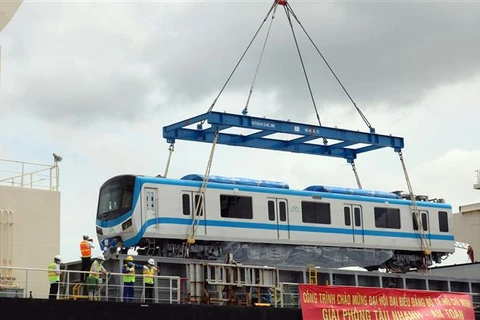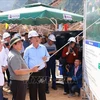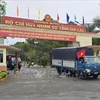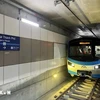 The Hanoi Metropolitan Railway Management Board on January 23 allowed people to visit the S1 Station and a train of the Nhon-Hanoi Station metro line. The event attracted hundreds of people, including children and elderly residents in Hanoi. The train travelled from Nhon Depot to the S5 station near the Army Theater, then back to the S1 station in front of the Hanoi University of Industry. The Hanoi Metropolitan Railway Management Board said the trial run last week lasted an hour at an average speed below 10 kilometres per hour. The train and S1 station will open for public viewing until June 24, with online registration starting January 15. (Photo: VietnamPlus)
The Hanoi Metropolitan Railway Management Board on January 23 allowed people to visit the S1 Station and a train of the Nhon-Hanoi Station metro line. The event attracted hundreds of people, including children and elderly residents in Hanoi. The train travelled from Nhon Depot to the S5 station near the Army Theater, then back to the S1 station in front of the Hanoi University of Industry. The Hanoi Metropolitan Railway Management Board said the trial run last week lasted an hour at an average speed below 10 kilometres per hour. The train and S1 station will open for public viewing until June 24, with online registration starting January 15. (Photo: VietnamPlus)  Visitors had to present their personal papers when registering to enter the station and the train inside. They were required to wear masks and sanitise their hands before entering the station to prevent the spread of the COVID-19 pandemic. The Hanoi Metropolitan Management Board will conduct a survey to collect pubic opinions on the project. The visitors will also be asked whether they are ready for traveling by train. This is the first train of the metro line, which reached the Nhon Deport from France three months ago. The second train destined for the metro line is expected to be delivered to Vietnam by the end of this month. (Photo: VietnamPlus)
Visitors had to present their personal papers when registering to enter the station and the train inside. They were required to wear masks and sanitise their hands before entering the station to prevent the spread of the COVID-19 pandemic. The Hanoi Metropolitan Management Board will conduct a survey to collect pubic opinions on the project. The visitors will also be asked whether they are ready for traveling by train. This is the first train of the metro line, which reached the Nhon Deport from France three months ago. The second train destined for the metro line is expected to be delivered to Vietnam by the end of this month. (Photo: VietnamPlus)  Among the 10 trains ordered, four would be included in the first batch to be delivered from France, the Hanoi Metropolitan Railway Management Board confirmed. The Nhon-Hanoi Station metro line will run 12.5 kilometres from Nhon in western Nam Tu Liem district through Kim Ma Street to the capital city's downtown railway station, and cost 33 trillion VND (roughly 1.42 billion USD). The station S1 with the length of 108 meters and the width of 24 meters is the first station of the metro line. It comprises two floors; ticket booths, shopping stores and eateries are located in the first floor. (Photo: VietnamPlus)
Among the 10 trains ordered, four would be included in the first batch to be delivered from France, the Hanoi Metropolitan Railway Management Board confirmed. The Nhon-Hanoi Station metro line will run 12.5 kilometres from Nhon in western Nam Tu Liem district through Kim Ma Street to the capital city's downtown railway station, and cost 33 trillion VND (roughly 1.42 billion USD). The station S1 with the length of 108 meters and the width of 24 meters is the first station of the metro line. It comprises two floors; ticket booths, shopping stores and eateries are located in the first floor. (Photo: VietnamPlus)  There are four ways to the S1 station with elevators including one for people with disabilities, elderly people, children and women. The train and S1 station will open for public viewing until June 24, with online registration starting January 15. The event aims to celebrate the 13th National Congress of the Communist Party of Vietnam (CPV), while publicising the progress of the project. To ensure safety for visitors amidst the COVID-19 pandemic and the undergoing construction, the Hanoi Metropolitan Railway Management Board asked people to make online registration and sent confirmations to visitors. The event attracted hundreds of people, including children and senior residents in Hanoi. The Hanoi Metropolitan Management Board will conduct a survey to collect pubic opinions on the project. (Photo: VietnamPlus)
There are four ways to the S1 station with elevators including one for people with disabilities, elderly people, children and women. The train and S1 station will open for public viewing until June 24, with online registration starting January 15. The event aims to celebrate the 13th National Congress of the Communist Party of Vietnam (CPV), while publicising the progress of the project. To ensure safety for visitors amidst the COVID-19 pandemic and the undergoing construction, the Hanoi Metropolitan Railway Management Board asked people to make online registration and sent confirmations to visitors. The event attracted hundreds of people, including children and senior residents in Hanoi. The Hanoi Metropolitan Management Board will conduct a survey to collect pubic opinions on the project. (Photo: VietnamPlus)  The visitors are divided into groups of 20, who are then instructed to walk to the platform to visit the train. The Nhon-Hanoi Station metro line will run 12.5 kilometres from Nhon in western Nam Tu Liem district through Kim Ma Street to the city's downtown railway station, and cost 33 trillion VND (roughly 1.42 billion USD). Its elevated section is expected to become operational by the end of 2021, while the underground section would be opened at the end of 2022. The first train to operate on the Nhon-Hanoi Station railway conducted a trial run last week, three months after it reached the Nhon Depot from France. In photo: An official briefs the visitors on the project. (Photo: VietnamPlus)
The visitors are divided into groups of 20, who are then instructed to walk to the platform to visit the train. The Nhon-Hanoi Station metro line will run 12.5 kilometres from Nhon in western Nam Tu Liem district through Kim Ma Street to the city's downtown railway station, and cost 33 trillion VND (roughly 1.42 billion USD). Its elevated section is expected to become operational by the end of 2021, while the underground section would be opened at the end of 2022. The first train to operate on the Nhon-Hanoi Station railway conducted a trial run last week, three months after it reached the Nhon Depot from France. In photo: An official briefs the visitors on the project. (Photo: VietnamPlus)  The train traveled from the Nhon Depot to the S5 station near the Army Theater, then back to the S1 station in front of the Hanoi University of Industry. The Hanoi Metropolitan Railway Management Board said the earlier trial run lasted an hour at an average speed below 10 kilometres per hour. The station S1 with the length of 108 meters and the width of 24 meters is the first station of the metro line. It comprises two floors; ticket booths, shopping stores and eateries are located in the first floor. There are four ways to the station with elevators including one for people with disabilities, elderly people, children and women. (Photo: VietnamPlus)
The train traveled from the Nhon Depot to the S5 station near the Army Theater, then back to the S1 station in front of the Hanoi University of Industry. The Hanoi Metropolitan Railway Management Board said the earlier trial run lasted an hour at an average speed below 10 kilometres per hour. The station S1 with the length of 108 meters and the width of 24 meters is the first station of the metro line. It comprises two floors; ticket booths, shopping stores and eateries are located in the first floor. There are four ways to the station with elevators including one for people with disabilities, elderly people, children and women. (Photo: VietnamPlus)  Each train of the metro line, designed with maximum speed of 80 kilometres per hour, is 80-meter-long and has four carriages for about 950 passengers. The trains will run at an average speed of 37 kilometres per hour. They are painted in light green, red and white, mimicking the colors of the dragon fruit, a specific fruit of Vietnam. They are fully equipped with air conditioners and ventilation systems, loudspeakers for announcements, surveillance cameras, standalone smoke and fire detectors, and LED lighting with auto-adjust brightness for underground route following the European standards. The visitors were briefed on the design and furniture in the train. (Photo: VietnamPlus)
Each train of the metro line, designed with maximum speed of 80 kilometres per hour, is 80-meter-long and has four carriages for about 950 passengers. The trains will run at an average speed of 37 kilometres per hour. They are painted in light green, red and white, mimicking the colors of the dragon fruit, a specific fruit of Vietnam. They are fully equipped with air conditioners and ventilation systems, loudspeakers for announcements, surveillance cameras, standalone smoke and fire detectors, and LED lighting with auto-adjust brightness for underground route following the European standards. The visitors were briefed on the design and furniture in the train. (Photo: VietnamPlus)  The Hanoi Metropolitan Railway Management Board asked visitors to present their personal papers when registering to enter the station and the train inside. The train is equipped with air conditioners, sound systems, benches, handles and electronic information displays. Once ready, the Nhon – Hanoi Station metro line is expected to serve more than 23,000 passengers per hour from 2021. The line is planned to have 10 France-manufactured trains with a capacity of 950 passengers each. The trains are expected to be operated at 35km per hour on average and 80km per hour maximum, the same speed as metros in Paris, Berlin and other Asian cities. (Photo: VietnamPlus)
The Hanoi Metropolitan Railway Management Board asked visitors to present their personal papers when registering to enter the station and the train inside. The train is equipped with air conditioners, sound systems, benches, handles and electronic information displays. Once ready, the Nhon – Hanoi Station metro line is expected to serve more than 23,000 passengers per hour from 2021. The line is planned to have 10 France-manufactured trains with a capacity of 950 passengers each. The trains are expected to be operated at 35km per hour on average and 80km per hour maximum, the same speed as metros in Paris, Berlin and other Asian cities. (Photo: VietnamPlus)  The Hanoi Metropolitan Railway Management Board said the train was designed to have a wide door, creating more space for passengers, especially passengers with restricted mobility, to get on and off. The colour of the trains is inspired by the colour of Vietnamese dragon fruit and yellow rice field that was warmly applauded by the public following a survey in September 2018, the board said. The Nhon-Hanoi Station route is 12.5 kilometres including 8.5 kilometres on elevated tracks and the remaining four kilometres underground. As per schedule, the 8.5-kilometre route on elevated tracks will run in April, 2021 and the next 4-kilometre route will operate at the end of 2022. (Photo: VietnamPlus)
The Hanoi Metropolitan Railway Management Board said the train was designed to have a wide door, creating more space for passengers, especially passengers with restricted mobility, to get on and off. The colour of the trains is inspired by the colour of Vietnamese dragon fruit and yellow rice field that was warmly applauded by the public following a survey in September 2018, the board said. The Nhon-Hanoi Station route is 12.5 kilometres including 8.5 kilometres on elevated tracks and the remaining four kilometres underground. As per schedule, the 8.5-kilometre route on elevated tracks will run in April, 2021 and the next 4-kilometre route will operate at the end of 2022. (Photo: VietnamPlus)  Once completed and put into operation, the trains will be able to carry 950 passengers each, with a density of 6-8 people for each square metre, and run at 35km per hour for commercial operation while their maximum designed speed is 80km per hour, similar to those in Paris, Berlin and other urban areas in Asia. This is taken as the standard design of metro lines in the world. The current speed of the buses in the capital averages 16 – 18 km per hour, and that of BRT, about 23km per hour. With a commercial operation speed of 35km per hour, coupled with considerable advantages such as comfort to passengers, safety level, costs, distance between stops, punctuality and superiority of the journeys compared to the distances, urban railway has become the optimal public means of transport. (Photo: VietnamPlus)
Once completed and put into operation, the trains will be able to carry 950 passengers each, with a density of 6-8 people for each square metre, and run at 35km per hour for commercial operation while their maximum designed speed is 80km per hour, similar to those in Paris, Berlin and other urban areas in Asia. This is taken as the standard design of metro lines in the world. The current speed of the buses in the capital averages 16 – 18 km per hour, and that of BRT, about 23km per hour. With a commercial operation speed of 35km per hour, coupled with considerable advantages such as comfort to passengers, safety level, costs, distance between stops, punctuality and superiority of the journeys compared to the distances, urban railway has become the optimal public means of transport. (Photo: VietnamPlus)  Vu The Anh, from Hanoi’s Bac Tu Liem district, said he had to queue since early morning to register for the experience. “As the train runs through my residential areas, I want the project to be completed soon,” he said. The urban railway line No.3, connecting Nhon and Hanoi Station, will span 12.5km, running through six districts: Nam Tu Liem, Bac Tu Liem, Cau Giay, Ba Dinh, Dong Da and Hoan Kiem. It consists of 12 stations including eight elevated and four underground. Its elevated section is expected to enter operation this year, while the underground section would be opened at the end of 2022. (Photo: VietnamPlus)
Vu The Anh, from Hanoi’s Bac Tu Liem district, said he had to queue since early morning to register for the experience. “As the train runs through my residential areas, I want the project to be completed soon,” he said. The urban railway line No.3, connecting Nhon and Hanoi Station, will span 12.5km, running through six districts: Nam Tu Liem, Bac Tu Liem, Cau Giay, Ba Dinh, Dong Da and Hoan Kiem. It consists of 12 stations including eight elevated and four underground. Its elevated section is expected to enter operation this year, while the underground section would be opened at the end of 2022. (Photo: VietnamPlus)  The Nhon-Hanoi Railway Station route consists of 10 trains, the first of which has four carriages each 80 meters long. The train was made with European standard aluminum alloy and manufactured by a French contractor. The train is colored green, red pink and white with an emblem of the Khue Van Cac, the Constellation of Literature pavilion inside the Temple of Literature in Hanoi, Vietnam’s first national university. In 2012, this pavilion was named an official symbol of the capital city. A ship carrying the first train for Hanoi’s second metro route from France docked at Hai Phong’s Nam Hai Dinh Vu Port last October. (Photo: VietnamPlus)
The Nhon-Hanoi Railway Station route consists of 10 trains, the first of which has four carriages each 80 meters long. The train was made with European standard aluminum alloy and manufactured by a French contractor. The train is colored green, red pink and white with an emblem of the Khue Van Cac, the Constellation of Literature pavilion inside the Temple of Literature in Hanoi, Vietnam’s first national university. In 2012, this pavilion was named an official symbol of the capital city. A ship carrying the first train for Hanoi’s second metro route from France docked at Hai Phong’s Nam Hai Dinh Vu Port last October. (Photo: VietnamPlus)  The train’s low floor makes it quite convenient for passengers to get on and off, especially for those with luggage or having to move on wheelchairs. There are priority areas for people with disabilities. The train is coloured green, red pink and white with an emblem of the Khue Van Cac, the Constellation of Literature pavilion inside the Temple of Literature in Hanoi, Vietnam’s first national university. In 2012, this pavilion was named an official symbol of the capital city. According to the Hanoi Metropolitan Railway Management Board, the train's colours were inspired by rice and dragon fruit, Vietnam’s famous agricultural product. It took years for the design unit to choose colours that both represent Vietnam and the capital of Hanoi, and are also suitable for travel. (Photo: VietnamPlus)
The train’s low floor makes it quite convenient for passengers to get on and off, especially for those with luggage or having to move on wheelchairs. There are priority areas for people with disabilities. The train is coloured green, red pink and white with an emblem of the Khue Van Cac, the Constellation of Literature pavilion inside the Temple of Literature in Hanoi, Vietnam’s first national university. In 2012, this pavilion was named an official symbol of the capital city. According to the Hanoi Metropolitan Railway Management Board, the train's colours were inspired by rice and dragon fruit, Vietnam’s famous agricultural product. It took years for the design unit to choose colours that both represent Vietnam and the capital of Hanoi, and are also suitable for travel. (Photo: VietnamPlus)  The trains are fully equipped with air conditioners and ventilation systems, loudspeakers for announcements, surveillance cameras, standalone smoke and fire detectors, and LED lighting with auto-adjust brightness for underground route following the European standards. The selection of the train’s design was also made after a survey by the Hanoi Metropolitan Railway Management Board in 2008 on opinions of more than 1,000 people of different ages, occupations and places of residence. More than 80 percent of interviewed people agreed with this design and over 90 percent said they were ready to use when the metro route begins operations. The project, which kicked off in September 2010, was scheduled to be completed in September 2017 but has had problems with land clearance, so the Hanoi People’s Committee extended the project deadline to 2022. (Photo: VNA)
The trains are fully equipped with air conditioners and ventilation systems, loudspeakers for announcements, surveillance cameras, standalone smoke and fire detectors, and LED lighting with auto-adjust brightness for underground route following the European standards. The selection of the train’s design was also made after a survey by the Hanoi Metropolitan Railway Management Board in 2008 on opinions of more than 1,000 people of different ages, occupations and places of residence. More than 80 percent of interviewed people agreed with this design and over 90 percent said they were ready to use when the metro route begins operations. The project, which kicked off in September 2010, was scheduled to be completed in September 2017 but has had problems with land clearance, so the Hanoi People’s Committee extended the project deadline to 2022. (Photo: VNA)  The Nhon-Hanoi Station line is one of the nine metro lines planned for Hanoi, which are expected to become the backbone of the traffic system in the capital city. It will help reduce CO2 emissions, thus contributing to the fight against climate change. The Hanoi municipal People’s Committee approved adjustments to the implementation duration and the capital structure of this project. Accordingly, the project will be carried out until 2022, instead of the initial deadline of September 2017. The elevated section will be put into use in April 2021 while the whole metro line will become operational in December 2022. Of the total investment capital of 1.17 billion EUR, Hanoi decided to reduce the funding sourced from the official development assistance (ODA) of the French Development Agency (AFD) from 178.7 million EUR to 158.7 million EUR, and raise the borrowing from the French Government from 335.4 million EUR to 355.1 million EUR. (Photo: VNA)
The Nhon-Hanoi Station line is one of the nine metro lines planned for Hanoi, which are expected to become the backbone of the traffic system in the capital city. It will help reduce CO2 emissions, thus contributing to the fight against climate change. The Hanoi municipal People’s Committee approved adjustments to the implementation duration and the capital structure of this project. Accordingly, the project will be carried out until 2022, instead of the initial deadline of September 2017. The elevated section will be put into use in April 2021 while the whole metro line will become operational in December 2022. Of the total investment capital of 1.17 billion EUR, Hanoi decided to reduce the funding sourced from the official development assistance (ODA) of the French Development Agency (AFD) from 178.7 million EUR to 158.7 million EUR, and raise the borrowing from the French Government from 335.4 million EUR to 355.1 million EUR. (Photo: VNA)  The trains are fully equipped with air conditioners and ventilation systems, loudspeakers for announcements, surveillance cameras, standalone smoke and fire detectors, and LED lighting with auto-adjust brightness for underground route following the European standards. Once completed and put into operation, the trains will be able to carry 950 passengers each, with a density of 6-8 people for each square metre, and run at 35km per hour for commercial operation while their maximum designed speed is 80km per hour, similar to that of those in Paris, Berlin and other urban areas in Asia. This is taken as the standard design of metro lines in the world. (Photo: VietnamPlus)
The trains are fully equipped with air conditioners and ventilation systems, loudspeakers for announcements, surveillance cameras, standalone smoke and fire detectors, and LED lighting with auto-adjust brightness for underground route following the European standards. Once completed and put into operation, the trains will be able to carry 950 passengers each, with a density of 6-8 people for each square metre, and run at 35km per hour for commercial operation while their maximum designed speed is 80km per hour, similar to that of those in Paris, Berlin and other urban areas in Asia. This is taken as the standard design of metro lines in the world. (Photo: VietnamPlus)  Hanoi’s Urban Transport Master Plan until 2030 with a vision to 2050 outlines the development for a core urban zone and additional satellite cities. The metro system is the backbone of the plan as it connects the inner zone to satellite cities, as well as other means of public transport like buses. According to the plan, Hanoi’s metro system will run a total length of 417km, of which approximately 76km will be underground. The Nhon-Hanoi Station urban railway project stretches 12.5km, including 8.5km above the ground and 4km under ground, crossing the districts of Bac Tu Liem, Nam Tu Liem, Cau Giay, Ba Dinh, Dong Da and Hoan Kiem. (Photo: VietnamPlus)
Hanoi’s Urban Transport Master Plan until 2030 with a vision to 2050 outlines the development for a core urban zone and additional satellite cities. The metro system is the backbone of the plan as it connects the inner zone to satellite cities, as well as other means of public transport like buses. According to the plan, Hanoi’s metro system will run a total length of 417km, of which approximately 76km will be underground. The Nhon-Hanoi Station urban railway project stretches 12.5km, including 8.5km above the ground and 4km under ground, crossing the districts of Bac Tu Liem, Nam Tu Liem, Cau Giay, Ba Dinh, Dong Da and Hoan Kiem. (Photo: VietnamPlus)  Vietnam is one of the fastest-growing economies in Asia. Vietnam’s cities are also experiencing rapid growth. It is expected that 50 percent of the population will live in urban areas by 2025. As the country’s capital, Hanoi needs to develop a suitable transportation infrastructure. Currently, public transport in Hanoi consists of only buses and taxis. There are two types of buses, regular buses and BRT buses. Once completed, this metro system, together with the current bus system, will be the backbone of the city’s public transport network. The Nhon-Hanoi Railway Station route consists of 10 trains, the first of which has four carriages each 80 meters long. The train was made with European standard aluminum alloy and manufactured by a French contractor. (Photo: VietnamPlus)
Vietnam is one of the fastest-growing economies in Asia. Vietnam’s cities are also experiencing rapid growth. It is expected that 50 percent of the population will live in urban areas by 2025. As the country’s capital, Hanoi needs to develop a suitable transportation infrastructure. Currently, public transport in Hanoi consists of only buses and taxis. There are two types of buses, regular buses and BRT buses. Once completed, this metro system, together with the current bus system, will be the backbone of the city’s public transport network. The Nhon-Hanoi Railway Station route consists of 10 trains, the first of which has four carriages each 80 meters long. The train was made with European standard aluminum alloy and manufactured by a French contractor. (Photo: VietnamPlus)  The Nhon-Hanoi Station line kicked off in September 2010 and was scheduled to be completed in September 2017. The Hanoi People’s Committee then decided to extend the project deadline. The 8.5km elevated section will be finished in April 2021 and the remaining 4km underground line will be opened in December 2022. Each train, which has a designed speed of 80 kph and a commercial speed of 35 kph, can carry 950 people. Its low floor makes it quite convenient for passengers to get on and off, especially for those with luggage or having to move on wheelchairs. There are priority areas for people with disabilities. (Photo: VietnamPlus)
The Nhon-Hanoi Station line kicked off in September 2010 and was scheduled to be completed in September 2017. The Hanoi People’s Committee then decided to extend the project deadline. The 8.5km elevated section will be finished in April 2021 and the remaining 4km underground line will be opened in December 2022. Each train, which has a designed speed of 80 kph and a commercial speed of 35 kph, can carry 950 people. Its low floor makes it quite convenient for passengers to get on and off, especially for those with luggage or having to move on wheelchairs. There are priority areas for people with disabilities. (Photo: VietnamPlus)  Under the Hanoi Metropolitan Railway Management Board’s plan, after the public viewing, the train will undergo a trial run from the Nhon Depot through the S1, S2, S3 and S4 Stations to the S5 Station. The Nhon-Hanoi Railway Station section, the second route after Cat Linh-Ha Dong, runs 12.5 kilometers from Nhon in the western district of Nam Tu Liem through Kim Ma Street to the city station in the downtown area. It will run 8.5 kilometers on elevated tracks and the remaining four kilometers underground. The tracks are supplied by a Russian company and installed by a French contractor. (Photo: VietnamPlus)
Under the Hanoi Metropolitan Railway Management Board’s plan, after the public viewing, the train will undergo a trial run from the Nhon Depot through the S1, S2, S3 and S4 Stations to the S5 Station. The Nhon-Hanoi Railway Station section, the second route after Cat Linh-Ha Dong, runs 12.5 kilometers from Nhon in the western district of Nam Tu Liem through Kim Ma Street to the city station in the downtown area. It will run 8.5 kilometers on elevated tracks and the remaining four kilometers underground. The tracks are supplied by a Russian company and installed by a French contractor. (Photo: VietnamPlus)  The Nhon-Hanoi Station metro line is expected to be put into operation in 2022. The Hanoi Urban Railway Management Board has announced that the Nhon depot of the Nhon-Hanoi Station Metro Project is opened for public viewing to celebrate the 13th National Congress of the Communist Party of Vietnam. The visiting hours will be from 9 am to 3 pm on January 23 and 24. After the visit, the Hanoi Urban Railway Management Board will gather the visitors' opinions about the project. The visitors will also be asked whether they are ready for traveling by train. In photo: Visitors inside a train carriage. (Photo: VietnamPlus)
The Nhon-Hanoi Station metro line is expected to be put into operation in 2022. The Hanoi Urban Railway Management Board has announced that the Nhon depot of the Nhon-Hanoi Station Metro Project is opened for public viewing to celebrate the 13th National Congress of the Communist Party of Vietnam. The visiting hours will be from 9 am to 3 pm on January 23 and 24. After the visit, the Hanoi Urban Railway Management Board will gather the visitors' opinions about the project. The visitors will also be asked whether they are ready for traveling by train. In photo: Visitors inside a train carriage. (Photo: VietnamPlus)  Dang Dinh Quy, from Kim Lien ward, Hanoi’s Dong Da district, said he is lucky to be one of the first visitors to the train. The train is coloured green, red pink and white with an emblem of the Khue Van Cac, the Constellation of Literature pavilion inside the Temple of Literature in Hanoi, Vietnam’s first national university. In 2012, this pavilion was named an official symbol of the capital city. According to Hanoi Urban Railway Management Board, the train's colours were inspired by rice and dragon fruit, Vietnam’s famous agricultural product. It took years for the design unit to choose colours that both represent Vietnam and the capital of Hanoi, and are also suitable for travel. (Photo: VietnamPlus)
Dang Dinh Quy, from Kim Lien ward, Hanoi’s Dong Da district, said he is lucky to be one of the first visitors to the train. The train is coloured green, red pink and white with an emblem of the Khue Van Cac, the Constellation of Literature pavilion inside the Temple of Literature in Hanoi, Vietnam’s first national university. In 2012, this pavilion was named an official symbol of the capital city. According to Hanoi Urban Railway Management Board, the train's colours were inspired by rice and dragon fruit, Vietnam’s famous agricultural product. It took years for the design unit to choose colours that both represent Vietnam and the capital of Hanoi, and are also suitable for travel. (Photo: VietnamPlus)  A representative from the Hanoi Metropolitan Railway Management Board said: "In Europe, many do not know Ha Long Bay, but they do know the dragon fruit. When people saw the design, some said they guessed that this train was made for Vietnam." The selection of the train’s design was also made after a survey by MRB in 2008 on opinions of more than 1,000 people of different ages, occupations and places of residence. More than 80 percent of interviewed people agreed with this design and over 90 percent said they were ready to use when the metro route begins operations. In photo: Visitors take photos at the station (Photo: VietnamPlus)
A representative from the Hanoi Metropolitan Railway Management Board said: "In Europe, many do not know Ha Long Bay, but they do know the dragon fruit. When people saw the design, some said they guessed that this train was made for Vietnam." The selection of the train’s design was also made after a survey by MRB in 2008 on opinions of more than 1,000 people of different ages, occupations and places of residence. More than 80 percent of interviewed people agreed with this design and over 90 percent said they were ready to use when the metro route begins operations. In photo: Visitors take photos at the station (Photo: VietnamPlus)  Hanoians enjoyed their first experience of the capital’s second metro line, the Nhon-Hanoi Station, which conducted a trial run late last week. The train traveled from the Nhon Depot to the S5 station near the Army Theater, then back to the S1 station in front of the Hanoi University of Industry. The train and S1 station will open for public viewing until June 24, with online registration starting January 15. After the visit, the Hanoi Urban Railway Management Board will gather the visitors' opinions about the project. The 12.5-km metro route which runs from Nhon Town in Nam Tu Liem District to Hanoi Railway Station in Dong Da District, will cost VND36 trillion (USD1.56 billion), sourced mainly from official development assistance (ODA) from France. (Photo: VietnamPlus)
Hanoians enjoyed their first experience of the capital’s second metro line, the Nhon-Hanoi Station, which conducted a trial run late last week. The train traveled from the Nhon Depot to the S5 station near the Army Theater, then back to the S1 station in front of the Hanoi University of Industry. The train and S1 station will open for public viewing until June 24, with online registration starting January 15. After the visit, the Hanoi Urban Railway Management Board will gather the visitors' opinions about the project. The 12.5-km metro route which runs from Nhon Town in Nam Tu Liem District to Hanoi Railway Station in Dong Da District, will cost VND36 trillion (USD1.56 billion), sourced mainly from official development assistance (ODA) from France. (Photo: VietnamPlus)  After three months since being transported into Vietnam from France, the first train of the route was run on the trial basis for 5 kilometres linking stations S1 and S5 in Nam Tu Liem district last week. The Hanoi Metropolitan Railway Management Board said the trial run lasted an hour with train’s average speed of below 10 kilometers per hour. The train stopped at every station and was technically checked. The train is operated at an idle and the driver is Mustapha Mdjkoune, an experienced operator from Alstom. Nhon-Hanoi Station metro route has a total of ten trains valued at 110 million EUR. The second train is expected to arrive at Hai Phong Port by late this month. In photo: Students enjoyed their first experience of the capital’s second metro line. (Photo: VietnamPlus)
After three months since being transported into Vietnam from France, the first train of the route was run on the trial basis for 5 kilometres linking stations S1 and S5 in Nam Tu Liem district last week. The Hanoi Metropolitan Railway Management Board said the trial run lasted an hour with train’s average speed of below 10 kilometers per hour. The train stopped at every station and was technically checked. The train is operated at an idle and the driver is Mustapha Mdjkoune, an experienced operator from Alstom. Nhon-Hanoi Station metro route has a total of ten trains valued at 110 million EUR. The second train is expected to arrive at Hai Phong Port by late this month. In photo: Students enjoyed their first experience of the capital’s second metro line. (Photo: VietnamPlus)  After the public viewing, the train will undergo a trial run from the Nhon Depot through the S1, S2, S3 and S4 Stations to the S5 Station. The Hanoi Urban Railway Management Board will gather the visitors' opinions about the project. The trains of the project are manufactured in France. The first train was brought to Vietnam on October 18 and was painted in yellow, red and grey. Each train is 80 metres long and has four carriages for 950 passengers. The train is fully equipped following the European standards. Low floors are also convenient for disabled people and those with heavy luggage. (Photo: VietnamPlus)
After the public viewing, the train will undergo a trial run from the Nhon Depot through the S1, S2, S3 and S4 Stations to the S5 Station. The Hanoi Urban Railway Management Board will gather the visitors' opinions about the project. The trains of the project are manufactured in France. The first train was brought to Vietnam on October 18 and was painted in yellow, red and grey. Each train is 80 metres long and has four carriages for 950 passengers. The train is fully equipped following the European standards. Low floors are also convenient for disabled people and those with heavy luggage. (Photo: VietnamPlus) VNA
